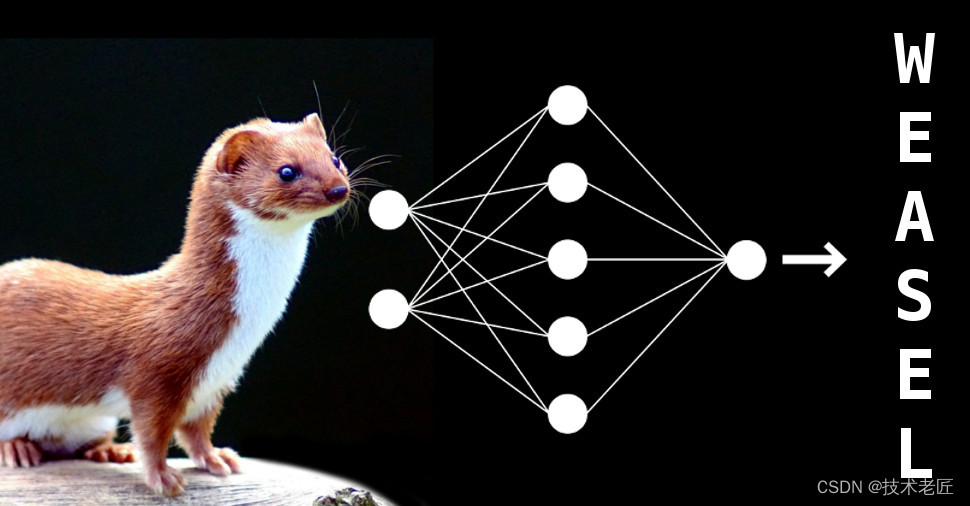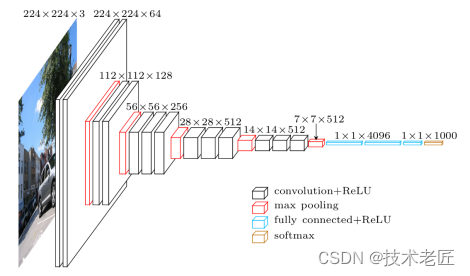在视觉领域可以分为:1、图像分类 2、语义分割 3、实例分割 4、目标检测(跟踪) 5、关键点检测。该篇主要讲解利用Tensorflow 对图像进行图像分类
前言
深度学习框架在市面上有很多。比如Theano、Caffe、CNTK、MXnet 、Tensorflow等。今天讲解的就是主角Tensorflow。Tensorflow的前身是Google大脑项目的一个分布式机器学习训练框架,它是一个十分基础且集成度很高的系统,它的目标就是为研究超大型规模的视觉项目,后面延申到各个领域。Tensorflow 在2015年正式开源,开源的一个月内就收获到1w多的starts,这足以说明Tensorflow的优越性以及Google的影响力。在Api方面Tensorflow为了满足绝大部分的开发者需求,这也是Google的一贯作风,集成了Java、Go、Python、C++等编程语言。
正文
图像识别是一件很有趣的事,话不多说,咱们先了解下特征提取VGG in Tensorflow。官网地址:VGG in TensorFlow · Davi Frossard。
VGG 是牛津大学的 K. Simonyan 和 A. Zisserman 在论文“Very Deep Convolutional Networks for Large-Scale Image Recognition”中提出的卷积神经网络模型。该模型在 ImageNet 中实现了 92.7% 的 top-5 测试准确率,这是一个包含 1000 个类别的超过 1400 万张图像的数据集。 在这篇简短的文章中,我们提供了 VGG16 的实现以及从原始 Caffe 模型转换为 TensorFlow 的权重。这句话是VGGNet官方的介绍,直接从它提供的数字可以看出来,它的识别率是十分高的,是不是很激动,动起手来吧。
开发步骤分4步,如下所示:
a) 依赖加载
import tensorflow as tf import numpy as np import matplotlib.pyplot as plt import os import scipy.io import scipy.misc from imagenet_classes import class_names
b)定义卷积、池化等函数
def _conv_layer(input,weight,bias): conv = tf.nn.conv2d(input,weight,strides=[1,1,1,1],padding="SAME") return tf.nn.bias_add(conv,bias) def _pool_layer(input): return tf.nn.max_pool(input,ksize=[1,2,2,1],strides=[1,2,2,1],padding="SAME") def preprocess(image,mean_pixel): '''简单预处理,全部图片减去平均值''' return image-mean_pixel def unprocess(image,mean_pixel): return image+mean_pixel
c)图像的读取以及保存
def imread(path): return scipy.misc.imread(path) def imsave(image,path): img = np.clip(image,0,255).astype(np.int8) scipy.misc.imsave(path,image)
d) 定义网络结构,这里使用的是VGG19
def net(data_path,input_image,sess=None):
"""
读取VGG模型参数,搭建VGG网络
:param data_path: VGG模型文件位置
:param input_image: 输入测试图像
:return:
"""
layers = (
'conv1_1', 'conv1_2', 'pool1',
'conv2_1', 'conv2_2', 'pool2',
'conv3_1', 'conv3_2', 'conv3_3','conv3_4', 'pool3',
'conv4_1', 'conv4_2', 'conv4_3','conv4_4', 'pool4',
'conv5_1', 'conv5_2', 'conv5_3','conv5_4', 'pool5',
'fc1' , 'fc2' , 'fc3' ,
'softmax'
)
data = scipy.io.loadmat(data_path)
mean = data["normalization"][0][0][0][0][0]
input_image = np.array([preprocess(input_image, mean)]).astype(np.float32)#去除平均值
net = {}
current = input_image
net["src_image"] = tf.constant(current) # 存储数据
count = 0 #计数存储
for i in range(43):
if str(data['layers'][0][i][0][0][0][0])[:4] == ("relu"):
continue
if str(data['layers'][0][i][0][0][0][0])[:4] == ("pool"):
current = _pool_layer(current)
elif str(data['layers'][0][i][0][0][0][0]) == ("softmax"):
current = tf.nn.softmax(current)
elif i == (37):
shape = int(np.prod(current.get_shape()[1:]))
current = tf.reshape(current, [-1, shape])
kernels, bias = data['layers'][0][i][0][0][0][0]
kernels = np.reshape(kernels,[-1,4096])
bias = bias.reshape(-1)
current = tf.nn.relu(tf.add(tf.matmul(current,kernels),bias))
elif i == (39):
kernels, bias = data['layers'][0][i][0][0][0][0]
kernels = np.reshape(kernels,[4096,4096])
bias = bias.reshape(-1)
current = tf.nn.relu(tf.add(tf.matmul(current,kernels),bias))
elif i == 41:
kernels, bias = data['layers'][0][i][0][0][0][0]
kernels = np.reshape(kernels, [4096, 1000])
bias = bias.reshape(-1)
current = tf.add(tf.matmul(current, kernels), bias)
else:
kernels,bias = data['layers'][0][i][0][0][0][0]
#注意VGG存储方式为[,]
#kernels = np.transpose(kernels,[1,0,2,3])
bias = bias.reshape(-1)#降低维度
current = tf.nn.relu(_conv_layer(current,kernels,bias))
net[layers[count]] = current #存储数据
count += 1
return net, meane)加载模型进行识别
if __name__ == '__main__':
VGG_PATH = "./one/imagenet-vgg-verydeep-19.mat"
IMG_PATH = './one/3.jpg'
input_image =imread(IMG_PATH)
shape = (1, input_image.shape[0], input_image.shape[1], input_image.shape[2])
with tf.Session() as sess:
image = tf.placeholder('float', shape=shape)
nets, mean_pixel, all_layers= net(VGG_PATH, image)
input_image_pre=np.array([preprocess(input_image,mean_pixel)])
layers = all_layers
for i , layer in enumerate(layers):
print("[%d/%d] %s" % (i+1,len(layers),layers))
features = nets[layer].eval(feed_dict={image:input_image_pre})
print("Type of 'feature' is ",type(features))
print("Shape of 'features' is %s" % (features.shape,))
if 1:
plt.figure(i+1,figsize=(10,5))
plt.matshow(features[0,:,:,0],cmap=plt.cm.gray,fignum=i+1)
plt.title(""+layer)
plt.colorbar()
plt.show()VGG19网络介绍
VGG19 的宏观架构如图所示。我们在 TensorFlow 中的文件 vgg19.py 中对其进行编码。请注意,我们包含一个预处理层,它采用像素值在 0-255 范围内的 RGB 图像并减去平均图像值(在整个 ImageNet 训练集上计算)。
总结
Tensorflow是一款十分不错的深度学习框架,它在工业上得到的十分的认可并进行了实践。因此,如果你还在犹豫生产落地使用框架,不要犹豫啦。VGGNet家族是一个十分优秀的网络结构,它在处理特征提取过程中,也是得到了很多公司和研究学者的认可,比较著名的有VGG16、VGG19等。
相关推荐






0评论